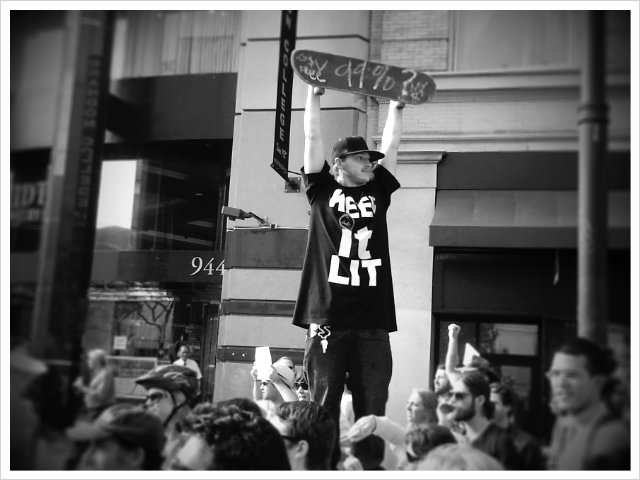
The first time I saw the Occupy SF encampment downtown, I wasn't much impressed. The Occupy Wall Street protest in Manhattan was growing rapidly, spawning similar groups in hundreds of cities around the world. When I visited our version early this month I wondered what I'd find: a fully formed movement or the typical San Francisco kabuki?
On first blush it looked like the latter. The encampment, huddled on the sidewalk in front of the Federal Reserve on Market Street, was a veritable Noah's Ark of lefty protest. There were dreads in camo pants, Boomers in recycled-rubber sandals, crust punks with Guy Fawkes masks -- red meat for Fox news, in other words.
But then a DPW street cleaning truck trundled by on Market Street. The guy in the passenger seat was leaning halfway out the window, high-fiving sign-waving protesters on the sidewalk. And every time the F-line passed the driver leaned on his horn, prompting a cheer from the protesters.
Clearly, this wasn't just another San Francisco protest.
A descendant of the radical farmers' protests in the 1930s and cousin to this year's Arab Spring, the movement's emergence makes sense given the economic bloodletting of recent years. Critics have made much of the fact that the occupiers lack a list of bullet-pointed demands. But, really, anyone who claims not to get the point is an idiot or a liar. In short: the system is broken, the game is rigged. The top 1 percent of the population owns 40 percent of the country's wealth. Something needs to change. As the Occupy SF manifesto puts it, "We want to define a new American Dream for ourselves."
And that's exactly what the protesters are trying to do. As in New York City, the occupation here began with the professional-protester types, the early adopters I saw on my first visit. Their role in getting the movement off the ground is crucial, but it can't grow without an influx of people who don't usually come out to protests. Early on, I met a bushy-haired 41-year-old from Ukiah who introduced himself as Just David. He had camped the previous three nights, and felt cautiously optimistic about where the movement was headed. He added, though, that "the 1960s model of just getting arrested isn't gonna work. We need new voices."
Slowly but surely, the movement seems to be drawing these new voices. Cassie Fairfield, for instance, a 24-year-old Berkeley cook and social media worker, sees this as a watershed moment for her generation. "We're not just sitting there complacently behind our computer screens anymore, tweeting about it," she says. "This feels like a big deal."
In mid-October, a Saturday march to City Hall drew thousands of people, a wall of humanity -- young and old, male and female, mainstream and hipster -- that filled 10 city blocks. Near UN Plaza, marchers set up a makeshift daycare; kids played in a blocked-off area near the fountain as the crowds streamed past, chanting "We are the 99 percent!"
The group's move from the Federal Reserve to Justin Herman Plaza has allowed it to expand -- more than 300 sleep there every night now in an ever-expanding tent city, dirtying up the Embarcadero's tourist-playground vibe. Some of the tents even sport addresses: "20 Justin Herman Plaza," one reads. There is a kitchen, a medical tent, a library. There are workshops ("nonviolent direct action"), visits by radical celebrities (Tom Morello, Naomi Klein), and performances by writers, dancers, and comedians. People pedaling bikes hooked up to car batteries provide electricity.
Uplifting, "power to the people" stuff all around. But the city fathers obviously wish the protests would just go away. Interim Mayor Ed Lee says he supports the occupiers "in spirit" but not in any tangible way, and each day brings a fresh bureaucratic skirmish with a different city agency, whether it's a ruling that the bike-powered lead-acid batteries have to go or a request that the group temporarily leave the plaza so it can be cleaned. The protesters can be their own worst enemies, too: calling the police "pigs," for instance, isn't the way to sway popular opinion.
The cops, for their part, have raided the camp every couple of weeks, forcing protesters to take down the tents and gather up their gear. On Tuesday the police sent the camp another eviction notice. It's probably just a matter of time before the next midnight raid, and it could be accompanied by the violence that turned this week's eviction of Occupy Oakland into a war zone.
So the future is unwritten. No one can say if Occupy SF will survive the winter-- -- or even next week. As long as the underlying grievances go unaddressed, however, the message seems likely to endure regardless of medium. As one protester's sign put it: "This is just the beginning."